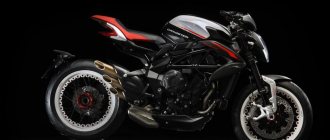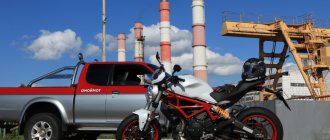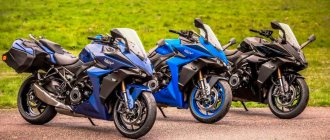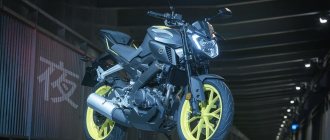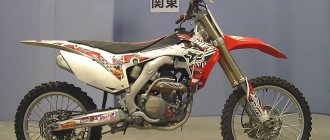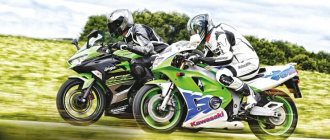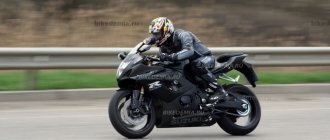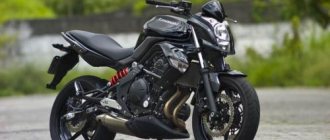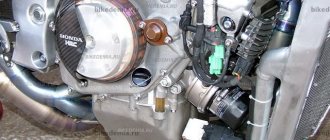000_moto_0211_064
But the device was created for a completely different purpose: to break the record in a quarter-mile race among scooters. But he never appeared in either Santa Pod or Elvington...
It’s unlikely that Marilyn “Marita” Parker could have imagined that her car, more than 40 years later, would mark the beginning of a whole direction in scooter tuning. Then, in 1965, the 22-year-old Englishwoman accelerated to 176 km/h on the Monza track, sitting in a knee-elbow position behind the wheel of a “naked” (but with a windshield), lowered and pumped up Lambretta. And this figure, not sour by today’s standards, was much more important than any stylistic delights. (They say that in one of the races, with more solid fairings, Marita reached over 200 km/h - but this record was not recorded.)
In October 2006, the guys from the workshop on the outskirts of the Scooter-Center post-shop, near Cologne, also least of all thought about the fame of customizers. But thoughts about the record recently set by competitors in the quarter haunted me. Jealousy towards the British from PM Tuning was un-Germanly hot - at least when they told me about plans to beat the achievement by more than a second. Moreover, “on the territory of the enemy and with his own weapons”: in Santa Pod and on a machine also built on the frame and crankcase of the Italjet Dragster 180. At the same time, no writhing: unlike the opponent, the future record holder must be thorough and neat in German.
Cutting off the frame at the rear, radically lowering it at the front, moving the power unit backwards and upwards (installing it directly into the silent bars instead of the usual complex “rocking chair”) - at that time this was fresh, at least for “new-school” vehicles (and Lambretta for drag racing and “ring” Group 6 had not yet traveled outside of Britain). As does the installation of a fiberglass “tail” of ring origin. The one-third completed car, resting on the slipway, appealed to me, a “hückster driver” with experience, a curious layout and design of the converted chassis - but at the same time caused skepticism due to its greater weight compared to the “British” one. Yes, and 10.5 seconds at quarter is a task, even for such a tiny thing requiring well over 40 hp. on the wheel (the “configs” of this motor known to me at that time promised a maximum of 35). “And we’ll fire it up with nitros!” - came the answer. Installing a “bite the raccoon” on a two-stroke is still considered extremely risky to this day due to the already increased sensitivity of such engines to the quality of the mixture, but the peremptory tone of the guys, coupled with the mischievous sparkle in their eyes, left no doubt about the success of the business.
Completed by July 2007, the shell looked militant. Low and long, neat and meticulous in detail, against the backdrop of the writhing that reigned in the then scooter drag racing, it looked like a jet attack aircraft in the ranks of rusty “whatnots” - which was also facilitated by the color (then matte khaki with white stenciled lettering) in the Bundeswehr spirit . And at the same time, there are no hints at an exhibition of the achievements of the scooter center. (A characteristic detail: instead of the most spectacular BGM handlebar with clip-ons adjustable in three planes, there is a modest - and at the same time not offered in the Scooter-Center catalog - but much lighter French Doppler.)
Tags [edit]
| Dragster 50 | Dragster 125 | Dragster 180 | Dragster 250 | |
| Engine | single cylinder two stroke engine | single cylinder two stroke engine | single cylinder two stroke engine | single cylinder four stroke engine |
| Capacity | 49 cu. cm (3.0 cu in) | 123 cu. cm (7.5 cu in) | 176 cu. cm (10.7 cu in) | 244 cc cm (14.9 cu in) |
| Bore × stroke | 41 mm × 37.4 mm (1.61 × 1.47 in) | 55 mm × 52 mm (2.2 in × 2.0 in) | 65.6 mm × 52 mm (2.58 in × 2.05 in) | 72 mm × 60 mm (2.8 in × 2.4 in) |
| Power/rpm | 3.3 kW (4.4 hp) 6800 rpm | 10.6 kW (14.2 hp) 7500 rpm | 14 kW (19 hp) 8000 rpm [5] | 16.2 kW (21.7 hp) [6] |
| Maximum speed [7] | 50 km/h (31 mph) | 103 km/h (64 mph) | 122 km/h (76 mph) | 125 km/h (78 mph) |
004_moto_0211_064
Marita still makes a splash at custom shows to this day.
But with success in German racing, everything is not so good - the “short” strip is not its format. The scooter never made it to “full-size” (402 m) strips. Marita still makes a splash at custom shows to this day. But with success in German racing, everything is not so good - the “short” strip is not its format. The scooter never made it to “full-size” (402 m) strips.
001_moto_0112_032
Driving ergonomics have not changed.
And the passenger... appeared - the thin convex rear seat on the previous model made it possible to carry “ballast” only from the bar to the metro. The new plastic is certainly more modern than the 1996 model. And the rear one is even better. It’s just that the new design lacks purebredness. Driving ergonomics have not changed. And the passenger... appeared - the thin convex rear seat on the previous model made it possible to carry “ballast” only from the bar to the metro. The new plastic is certainly more modern than the 1996 model. And the rear one is even better. It’s just that the new design lacks purebredness.
013_moto_0211_064
“Nitros”, remote “house”, long-stroke crankshaft - this is an incomplete list of new Scooter-Center products tested on this crazy sausage.
“Nitros”, remote “house”, long-stroke crankshaft - this is an incomplete list of new Scooter-Center products tested on this crazy sausage.
But the indicators... At the stand the device produced 32.5 hp. “honest” and 43.4 - with nitros. A lot, a lot - but in the Republic of Moldova they already “taught how to drive” the X2 350 (the same carbon Lambretta that later received the nickname Double Trouble). But it became a “Problem” for the creators later; and then the issues of fine-tuning the two-cylinder engine (more precisely, transmitting power from it to the wheel) were considered solvable. The Germans did not want to lose face, and therefore decided to focus on another Wunderwaffe - with a lightweight dragster chassis made of aluminum pipes and with a two-cylinder “big block”, which by that time was already producing 51.7 hp. on the wheel. Then the Germans had no interest in the British market, and on the 150-meter strips of the German championship they needed other devices - but that’s a completely different story.
What about super-Italjet? They decided to make it a full-fledged demo device - more for custom shows than for races. The car was polished, equipped with baubles and mules from the Scooter-Center catalog and repainted in the company color all winter. And at the same time they were putting into relative order another piece of equipment that they had acquired by chance - and only after bringing it to their native Germany did they realize what a treasure was in front of them: the first “pro-stock” scooter that accelerated to 110 mph. General concept, similar proportions and dimensions, just 42 years apart. The idea of exhibiting two devices on one stand suggested itself. Just like the “little one”’s name. More precisely, the youngest...
PS In 2007, Bob Forrest-Webb, the designer of that same Lambretta, decided to assemble the old team for new exploits. Found everyone except Marita. The search for the dashing taxi driver, once selected from 67 candidates, lasted two years with the involvement of archives, police and the press, but ended in nothing. All that remained were newspaper photos of a brunette with a Babette haircut in a white jumpsuit - and the car being restored by Scooter-Center, now together with Bob and his team.
Marita Scooter-Center
THINGS AND SUBSTANCES:
List A:
- Piaggio Bigblock engine, crankcase reinforced and modified for an enlarged valve, BGM crankshaft (54 mm stroke), Malossi 172 CPG (finishing, porting), BGM head, Dell' Orto VHSG 39 carburetor, Tassinari RD350 valve, MMV manifold, NX Piranha nitrous, S-and-S exhaust, HPI ignition.
- CVT, clutch (Delta Clutch), torque driver, belt - all Malossi.
- Modification of the frame and steering gear, fairings - all Scooter-Center, rear "crutch" BGM, Bitubo shock absorbers, Galfer brake discs, Grimeca calipers.
List B:
- Doppler Buffalo steering wheel, Piaggio Typhoon 125 snorkel and cover cap, Vespa kickstarter lever.
002_moto_0112_032
The main frame pipes (now only “long”) have become larger in diameter.
Production is still Italian. But the shock absorbers are Asian: what can you do, Paioli no longer exists... The main frame pipes (now only “long”) have become larger in diameter. Production is still Italian. But the shock absorbers are Asian: what can you do, Paioli no longer exists...
014_moto_0211_064
The first scooter specially prepared for drag racing is considered to be the demo machine of the Ankillotti brothers from Firenza, whose company at that time was producing tuning kits for Lambretta.
On October 16, 1966, in the British city of Elvington, the first scooter record was set on a quarter: 15.129 s (finish line speed - 96.5 km/h). The “donor” of the car was the “killed” Li125 1 series produced in 1958; Regular 92-grade gasoline was poured into the tank, and a FIAT 600 was brought in as a “technical vehicle”, on the roof of which the dragster was transported. The first scooter specially prepared for drag racing is considered to be the demo machine of the Ankillotti brothers from Firenza, whose company at that time was producing tuning kits for Lambretta. On October 16, 1966, in the British city of Elvington, the first scooter record was set on a quarter: 15.129 s (finish line speed - 96.5 km/h). The “donor” of the car was the “killed” Li125 1 series produced in 1958; Regular 92-grade gasoline was poured into the tank, and a FIAT 600 was brought in as a “technical vehicle”, on the roof of which the dragster was transported.
003_moto_0112_032
The tank and battery have swapped places.
It is now easier to tinker with the battery (which is important for “large” versions that do not have a kickstarter). But refueling will be inconvenient - and you will have to do it more often (the tank has shrunk almost in half!). The tank and battery have swapped places. It is now easier to tinker with the battery (which is important for “large” versions that do not have a kickstarter). But refueling will be inconvenient - and you will have to do it more often (the tank has shrunk almost in half!).
015_moto_0211_064
The speed record for a distance of 400 m with a standing start among scooters still belongs to the demo machine of the British PM Tuning.
Joe Elliott completed the quarter in 11.9 seconds (finish line speed - 168.5 km/h) on August 12, 2006 at the track in Santa Pod. The Pro Sprint scooter was built on the basis of the Italjet Dragster 180 with the maximum use of “hardware” produced by PM Tuning, and a minimum of “outside” components. So, the engine cylinder was “shaved down” from the original one, and the power system was left “honest”, without nitrous. The speed record for a distance of 400 m with a standing start among scooters still belongs to the demo machine of the British PM Tuning. Joe Elliott completed the quarter in 11.9 seconds (finish line speed - 168.5 km/h) on August 12, 2006 at the track in Santa Pod. The Pro Sprint scooter was built on the basis of the Italjet Dragster 180 with the maximum use of “hardware” produced by PM Tuning, and a minimum of “outside” components. So, the engine cylinder was “shaved down” from the original one, and the power system was left “honest”, without nitrous.
Her name was Marita: Italjet Dragster 179
004_moto_0112_032
The dashboard has become more modern, the samovar shine has disappeared from the plastic trim.
But the steering switches are frankly cheap, although the presence of hazard warning and switchkiller buttons is welcome. The dashboard has become more modern, the samovar shine has disappeared from the plastic trim. But the steering switches are frankly cheap, although the presence of hazard warning and switchkiller buttons is welcome.
| TECHNICAL CHARACTERISTICS Italjet Dragster 50 (manufacturer data) | |
| COMMON DATA | |
| Model year | 2012 |
| Dry weight, kg | 95 |
| Length × width × height, mm | 1800×700×1120 |
| Base, mm | 1315 |
| Seat height, mm | 660 |
| Ground clearance, mm | 135 |
| Reach, mm | 100 |
| Steering column tilt angle, degrees. | 27,5 |
| Gas tank volume, l | 6,8 |
| ENGINE | |
| Type | 1-cyl., 2T |
| Working volume, cm³ | 49 |
| Cylinder diameter × piston stroke, mm | 40×39,2 |
| Compression ratio | 7,0:1 |
| Supply system | carburetor |
| Cooling system | liquid |
| Starting system | electric starter |
| TRANSMISSION | |
| Variable speed drive | |
| CHASSIS | |
| Frame | spatial, steel |
| Front suspension | on the steering knuckle and trailing arm, spring preload adjustment |
| Rear suspension | pendulum, with monoshock absorber, adjustable spring preload |
| Brake system | separate, hydraulic |
| Front brake | disc Ø 175 mm, 2-piston opposed caliper |
| Rear brake | disc Ø 175 mm, 2-piston opposed caliper |
| Wheels | cast |
| Front tire | 120/70–11 |
| Rear tire | 130/60–13 |
Spaghetti and bolognese: Italjet Dragster 50
History of Italjet
The history of this brand is, first of all, the story of one person, its founder and permanent CEO Leopoldo Tartarini, an excellent designer and brilliant designer. The son of a famous motorcycle racer in Italy in the 1930s, Tartarini himself began his racing career in the early 1950s, which led him to Ducati. But Leopoldo soon developed a taste for independent design work and eventually founded his own company. It must be said that Tartarini maintained close ties with Ducati until the early 80s, took part in the design of many legendary motorcycles of this brand and even assembled some Ducati models at his factory. Tartarini chose a unique key to success: cheap engines from Eastern Europe plus high-quality Italian components and modern design. His first motorcycle, which was released in 1959, was equipped with a 123 cc two-stroke MCet (MZ) engine with 6.5 hp. But if the “donor”, with its weight of 107 kg and spark plug suspension of the rear wheel, was archaic even by the standards of the late 50s and did not shine with beauty, then Leopoldo’s creation was distinguished by an elegant “racing” appearance, a modern chassis and weight only 75 kg. And the “Junior” option with boost to 11 hp. the engine reached a maximum speed of 120 km/h! Since at first only MCet engines were used on German-Italian cars (since 1960, in addition to the 123 cc, and 172 cc), Tartarini named his own (Italemmezeta). The model range in 1964 was supplemented by a light motorcycle with a backbone frame and two versions of 50 cc engines - the Mustang with the Italian Minarelli engine and the Export with the Czech Jawa engine, which had a horizontal cylinder. Since Tartarini was no longer focused only on MCet motors, he changed the name of his (Italjet). In the fall of 1965, at the Milan Motor Show, Leopoldo presented a prototype of the “Grifon” motorcycle (Italjet Grifon) with a 490 cc two-cylinder overhead valve engine from the English (Triumph). Moreover, he obtained from the British the right to officially use these engines, which they had not granted to anyone until that moment. The Griffin went into production in 1966, but with a more powerful Triumph engine, a 649 cc 50-horsepower unit. The company introduced a whole series of minibikes in 1967. "Go-Go" (Italjet Go-Go), "Scout" (Italjet Scout) and "Ranger" (Italjet Ranger) had 49 cc two-stroke Minarelli engines in a block with four-speed gearboxes, an open-top duplex frame and 10- inch wheels. The difference between them came down to different shapes of the gas tank, steering wheel and trim. The development of this series was in 1969 the miniature “Kit Kat” (Italjet Kit Kat) on 7-inch wheels with a horizontal 49 cc engine under the deck. The last motorcycles with engines from the Eastern Bloc were the 350 model of 1968 with a two-cylinder two-stroke 344 cc Jawa engine and the Italjet Rally model of 1969 with a single-cylinder two-stroke 123 cc CZet engine. Tartarini opened a new niche for his products in the early 70s, starting the preparation of motorcycles for children's sports. The first of the new series was in 1971 the Junior Cross model, intended for children over 7 years old, with a 48 cc engine without gearbox and 14-inch wheels. It was followed in 1973 by the Mini Bambino, for children from 3 to 7 years old, with 8-inch wheels and a similar powertrain, and the Mini Enduro, for children over 10 years old, from 70 -cc engine, four-speed gearbox and 16-inch wheels. The range of machines for motocross and enduro competitions was supplemented in 1975 by the Mini Trial and Junior Trial. At the same time, the company produced a wide range of lightweight 125 cc motorcycles: sports cars for motocross and enduro, dual-purpose motorcycles, as well as the road sports model Buccaneer with a two-cylinder two-stroke 123 cc Yamaha engine with a power of 18 liters .With. The pinnacle of the minibike series was the Pack, introduced in 1979, a folding machine on 6-inch wheels with such a great design that it was included in the exhibition at the Museum of Modern Art in New York. In the early 80s, the company, while continuing to produce a wide range of motorcycles for children's competitions, chose a narrower specialization in “adult” motorsports. The former cross-country and enduro motorcycles were replaced by trial motorcycles with two-stroke engines with a displacement of 49 to 326 cm3. The road range was completely changed in 1982. The previous lightweight motorcycles have been replaced by a new family of dual-purpose enduro and trial motorcycles with 326 cc two-stroke and 322 cc four-stroke engines. Unfortunately, this family, despite the perfect technical content and ultra-fashionable design that reaches the point of extravagance (and perhaps precisely because of it), was not liked by buyers. At the same time, economically beneficial ties with Ducati were also interrupted, which came under the control of the Cagiva concern. Tartarini found a way out of a difficult situation by turning to scooters. In 1989, two models debuted with 49 cc two-stroke engines and automatic V-belt CVTs - “Reporter” (Italjet Reporter) on 10-inch wheels and “Italjet Shopping” on 16-inch wheels. In 1991, they were followed by the sports models “Pista” (Italjet Pista) and “Scoop” (Italjet Scoop) - the latter with the original “motorcycle” landing. It must be said that here Tartarini followed the “Asian” path, widely using components made in Taiwan and South Korea, and some of his models of those years were simply renamed cars from Southeast Asia. Completely original Italjet scooters appeared in 1993 in two completely different versions. The Italjet Velocifero 50 model is designed in the spirit of Italian scooters of the 50s. The Formula 50 scooter (Italjet Formula 50), on the contrary, is emphatically avant-garde both externally and technically. Thus, its front suspension is made on a trailing arm with a cantilever wheel mount. A year later, this original car was shown with a 114 cc, 13 hp, two-cylinder, two-stroke, liquid-cooled engine developed specifically for this model (Franco Morini). The 1995 debutant, the Italjet Dragster scooter, continued the Formula line, but its appearance with an open spatial tubular frame is even more avant-garde. At first, this machine used only a 49 cc two-stroke liquid-cooled engine, but in 1998 it received Piaggio two-stroke liquid-cooled engines with a displacement of 123 cm3 (15 hp) and 176 cm3 (21 hp) . The model remains the standard of a sports scooter to this day, possessing unsurpassed dynamics and handling. The city scooter "Torpedo" (Italjet Torpedo) on 16-inch wheels debuted in 1997 with a 49 cc two-stroke engine. A year later, a version with a 124 cc four-stroke engine appeared, and in 1999 - with a 49 cc four-stroke engine. In the same year, the program was supplemented by the business class scooter “Italjet Millennium”, equipped with a two-stroke (101 cm3) or four-stroke engine (124 and 152 cm3). In the fall of 2000, at the motor show in Munich, the cruising class scooter “Jupiter” (Italjet Jupiter) with a 249 cc four-stroke liquid-cooled engine was presented. This is a joint development of Italjet and the Chinese corporation Jincheng. New versions of this car with 125 cc and 150 cc engines have been prepared for the 2002 season. Italjet scooters are in great demand in Europe, America and Japan. Sports, film and pop stars ride them. But Tartarini does not rest on this. In the fall of 1998, his company introduced a 125 cc racing motorcycle for performance in the world championship. And in 1999 she showed a prototype of the Griffin motorcycle. It was equipped, like the model of the same name from 35 years ago, with a Triumph engine, this time with a modern 900 cc three-cylinder liquid-cooled unit. New for 2001 was the Jet-Set scooter with a distinctive design that closely resembles modern Audi cars and a large selection of power plants. So far the company offers four-stroke engines with displacements of 125 and 150 cm3, but is preparing to produce a variant with a 50 cc two-stroke engine.
